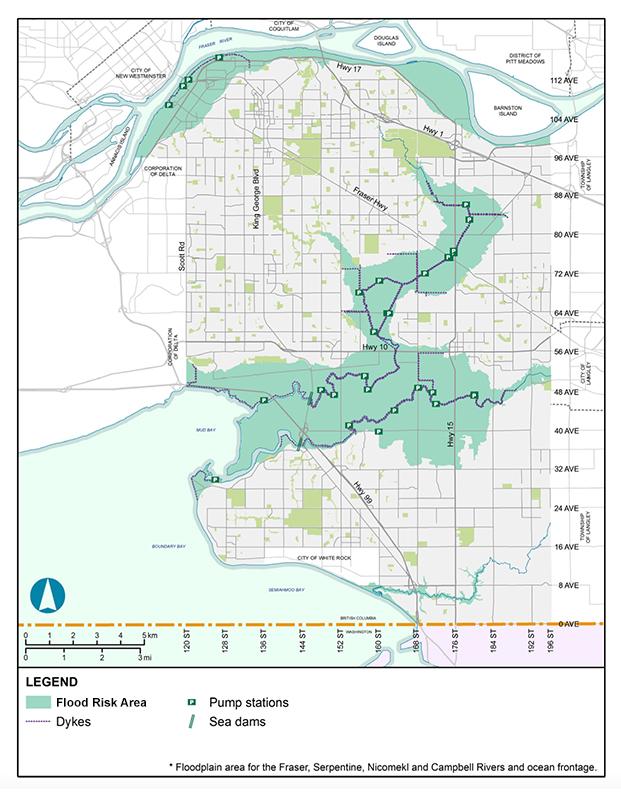Flood Preparedness
Learn how to prepare for and what to do during a flood.
Flood risk areas
View the map for high-risk flood areas in Surrey.
Flood protection
Learn how to prevent minor flooding around your home due to heavy rains.
Insurance
Flood damage is not often covered by your homeowner’s insurance policy. Consult your insurance broker regarding your coverage and take proactive steps in moving your precious items out of a flood area for safeguarding.
Immediate threat of flooding
Electrical service
- Shut off power to premises
- If the main switch is in an area that is already wet, stand on a dry board and use a dry stick to turn switch off.
- Do not attempt to turn off power if the room is already flooded
Electrical appliances
- Disconnect all electrical appliances, and if possible, move them to a higher level. Thermally insulated appliances such as freezers, refrigerators and ranges should be given priority
- Any appliances that cannot be moved should have motors, pumps, fans, etc. removed to higher levels
Gas or oil furnaces and appliances
- Oil or water tanks will float if not full. Fill if possible, then plug vent holes. If unable to fill, weight down with sandbags or wedge against a solid object
Plumbing fixtures and water supplies
- Turn off water supply
- Plug all basement sewage connections, e.g. toilet, sinks, showers, etc. with a plug or other device. The plug should be held in place with a weight or wood brace to the joist above.
Other precautions
- Pesticides, weed killers, fertilizers and other articles that may cause pollution should be moved to higher levels.
- To relieve overloading the sewer system, disconnect any downspouts draining to them.
- Move or remove all furniture and personal effects that could be damaged by flooding or that may float and cause damage.
Sandbagging
- If constructing a sandbag dike, build it on high ground close to your home or building. This ensures fewer sandbags will be needed and the dike will be less exposed to nearby streams.
- Dig a trench one bag in depth and two bags wide as a foundation for the dike structure.
- To be effective, a dike must be three times as wide at its base as it is high.
When flooding occurs
If rising waters become a threat to your safety, obey all officials who are involved in rescue or flood control operations, including those directing traffic, as water can be deeper than it appears.
Outdoors
- Climb to high ground and stay there.
- Avoid walking through any floodwaters.
In a vehicle
- Take extra care when driving. Familiar roads will appear drastically different when covered by floodwaters.
- Be on the lookout for damaged bridges, slides and washouts, and especially downed power lines.
- If you come to a flooded area, choose an alternate route.
- If your car stalls, abandon it immediately and climb to higher ground.
In your home
- Be sure you know where your emergency supply kit is.
- Follow your family emergency plan.
- Ensure each member of the family has warm clothing and waterproof footwear and outerwear.
- If you need to use a different meeting place than agreed on in your emergency plan because of flooding, make sure every member of the household knows where the new location is. Provide younger children with a note sealed in plastic stating the family’s destination.
- Turn off power and unplug all appliances.
After a flood
Flooding assistance
- Find helpful resources in the Disaster Recovery Guide.
- As an individual, family or small business, you may be able to receive Provincial Disaster Financial Assistance (DFA) if insurance is not available.
- You may be able to receive assistance through the Red Cross through their Financial Assistance Program, which raises donations.
Flooding along the Fraser River
Flooding along the Fraser River can occur to seasonal snow melt and heavy rains.
- View Fraser River Flood Risk to see the areas of potential flood and what you need to know in the event of a flood.
- Download the Fraser River Flood Preparedness Guide for residents and businesses to learn how to minimize flood damage to your property and protect yourself.
